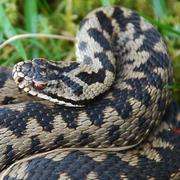Snake experts from Natural England, the Zoological Society of London (ZSL) and Oxford University have teamed up to perform a vital health check on Britain’s only venomous snake, the adder, following worrying declines.
With its iconic zig-zag markings, the adder was once a common sight in large parts of the British countryside. But in the last decade it has slipped into decline, with surveys suggesting a third of remaining adder populations may comprise fewer than ten adults.
Scientists believe this is down to the disappearance, degradation and fragmentation of habitat, resulting in smaller and more isolated populations of this enigmatic reptile.
It is feared that if these smaller populations, particularly in the English Midlands, are not able to maintain a healthy level of genetic diversity, their resilience to disease will be reduced and a concentration of genetic defects could occur, leading to local extinctions.
For the first time, a team of snake experts are heading into the undergrowth to obtain genetic samples from adders. This simple, harmless test involves taking a DNA swab, which can be used to determine current levels of genetic diversity.
Whilst the scientific procedure is risk-free for the snakes, the experts will be taking every safety precaution necessary to avoid being bitten – this is not something that should be tried at home.
Dr. Trent Garner, Senior Research Fellow at ZSL’s Institute of Zoology said: “Genetic diversity has been shown to be a key component for successful adder populations in Sweden and Hungary, but has yet to be studied in the UK. Our goal is to provide the first insights into how population size and isolation may be related to genetic diversity of the UK’s adders.”
Jim Foster, reptile specialist for Natural England, said: “With around a third of adder populations now restricted to isolated pockets of habitat, and with only a handful of snakes per site, they could be especially vulnerable.
“Habitat restoration and the creation of wildlife corridors will help get these snakes back on the move. We may even consider moving adders between populations, to artificially promote “gene flow” - although that carries risks and we’d need to look more closely at the genetics results before proceeding.”
Provided by Zoological Society of London





















